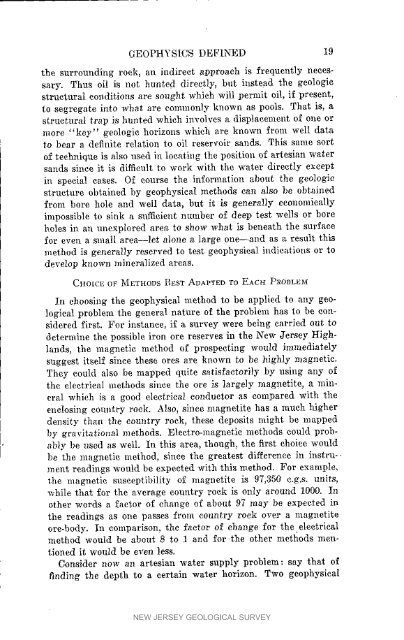Bulletin 54. Geophysical Methods of Exploration and their ...
Bulletin 54. Geophysical Methods of Exploration and their ...
Bulletin 54. Geophysical Methods of Exploration and their ...
You also want an ePaper? Increase the reach of your titles
YUMPU automatically turns print PDFs into web optimized ePapers that Google loves.
GEOPHYSICS DEFINED 19<br />
the surrounding rock, au indirect approach is frequently necessary.<br />
Thus oil is not hunted directly, but iustead the geologic<br />
structural conditions are songht which will permit oil, if present,<br />
to segregate into wbat are commonly known as pools. That is, a<br />
structural trap is bunted which involves a displacement <strong>of</strong> one or<br />
more "key" geologic horizons which are known from well data<br />
to bear a definite relation to oil reservoir s<strong>and</strong>s. This same sort<br />
<strong>of</strong> technique is also used in locating the position <strong>of</strong> artesian water<br />
s<strong>and</strong>s since it is difficult to work with the water directly except<br />
in special cases. Of course the information about the geologic<br />
structure obtained by geophysical methods can also be obtained<br />
from bore hole <strong>and</strong> well data, but it is generally economically<br />
impossible to sink a muffieient number <strong>of</strong> deep test wells or bore<br />
holes in an mmxplored area to show what is beneath the surface<br />
far even a small area--let alone a large one--<strong>and</strong> as a result this<br />
method is geuerally reserved to test geophysical indications or to<br />
develop known mineralized areas.<br />
CHOICE OF _,/[ETHODS ]:_EST ADAPTED TO EACFI PROBLEM<br />
In choosing the geophysical nlethod to be applied to any geological<br />
problem the general nature <strong>of</strong> the problenl has to be considered<br />
first. For instance, if a survey were being carried out to<br />
determine the possible iron ore reserves in the New Jersey Highl<strong>and</strong>s,<br />
the magnetic method <strong>of</strong> prospecting would immediately<br />
suggest itself since these ores are known to be highly magnetic.<br />
They could also be mapped quite st_tisfactorily by using any <strong>of</strong><br />
the electrical methods since the ore is largely magnetite, a mineral<br />
which is a good electrical conductor as compared with the<br />
enclosing country rock. Also, since magnetite has a much higher<br />
density thau the eomltry rock, these deposits might be slapped<br />
by gravitational methods. Electro-magnetlc methods could probably<br />
be used as well. In this area, though, the first choice would<br />
be the msgnetie method, since the greatest difference in instru-.<br />
ment readings would be expected with this method, For example,<br />
the magnetic susceptibility <strong>of</strong> magnetite is 97,350 c.g.s, units,<br />
while that for the average country rock is only around 1000. In<br />
other words a factor <strong>of</strong> change <strong>of</strong> about 97 may be expected in<br />
the readings as one passes from country rock over a magnetite<br />
ore-body. In comparison, the factor <strong>of</strong> change for the electrical<br />
method would be about 8 to i <strong>and</strong> for the other nlett_ods mentioned<br />
it would be even less.<br />
Consider now an artesian water supply problem: say that oi<br />
finding the depth to a certain water horizon. Two geophysical<br />
NEW JERSEY GEOLOGICAL SURVEY

















